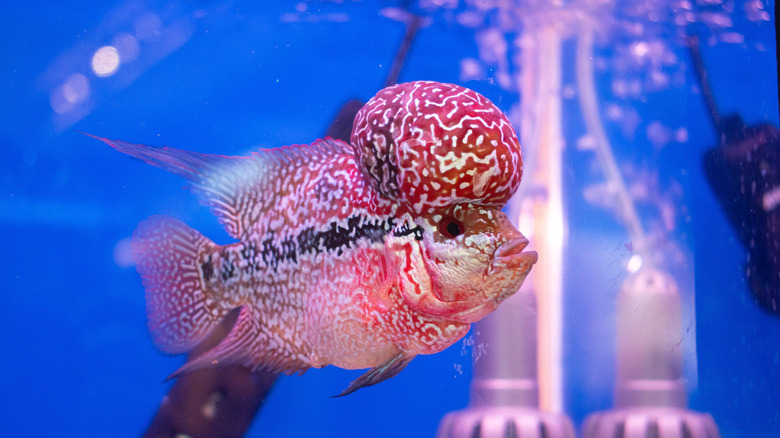How To Tell The Difference Between A Male And Female Flowerhorn Fish
Flowerhorn fish are beautiful and entertaining cichlids that were developed artificially for their looks. It's easy to tell flowerhorn sex in your tank based on the shape of the head and the size and shape of the fins.The feminine nuchal hump is much smaller than the male's, and in some types of flowerhorns, it might not even appear on females at all.
Female flowerhorn with a kok
That huge hump on a flowerhorn's head might look like an external brain, but the function of this gelatinous lump is merely ornamental. It's known as a nuchal hump and is also called a kok. When you're looking at a flowerhorn cichlid with a huge kok, you're definitely looking at a male.
However, it's not unusual for a female flowerhorn to also have a kok, but if they do have one it is likely to be much smaller than the male's. The kok of both female flowerhorn and males is made of soft tissue and can be easily injured. To prevent damage to the structure, keep a flowerhorn-only tank with only one male and two or three females. Male flowerhorn fish also do well on their own, and their large size and their intelligence make them fascinating fish.
Other flowerhorn sex giveaways
By the time flowerhorns are 4 inches long, their sex is easily identified not only by the kok but other physical attributes as well. The fish can grow an inch plus every month for the first year of life, so you should have a good idea of who is whom by the time your fish are 6 months old.
As they mature, males develop long fins that come to a point at the end. Females' fins stay shorter and are rounded on the end. The smaller females are also less brightly colored than the males.
Flowerhorn behavioral differences
Flowerhorn cichlids are a very aggressive species. If kept in a tank with other fish, they should share with fish of the same size and temperament. If your flowerhorn is very aggressive, you might wish to keep him in a tank by himself or with a divider separating him from his mate. When you observe breeding interest between the pair, it's easy enough to remove the partition.
Females kept together can be a part of a peaceful harem tank with other members of their own species. They can also coexist with other species of similar size and temperament. If keeping females with a male, it's best to keep two to three to divert any aggressive behavior away from any one fish in particular.
Female flowerhorn typically follow the male around the tank, basking in his protection as he defends his territory and females against any intruders. They need to stay out of sight as well as out of range of his aggressive nips, and this position offers both. Males can be so aggressive that they can bite you when you put your hand in the tank to rearrange decorations. Hand-feeding your juvenile male can help curb this territorial response.
Look at the vent
Although sex is usually obvious by the time a fish reaches 4 inches in length, there is one final way to tell flowerhorn male and female differences. This involves looking at the vent or anal pore beneath the anal fin. You might be able to see the anal pore when your fish is resting. The indentation for a male flowerhorn fish has a shape like the letter V. Female fish anal pores more closely represent the letter U.
As a last resort, you can net your fish and gently lift the fish above the water, holding firmly with your hand supporting the back. Keep the fish just above water level and turn the fish to the side enough to get a view of the vent. This is stressful for the fish, who might wriggle so much that it's not easy to tell.
